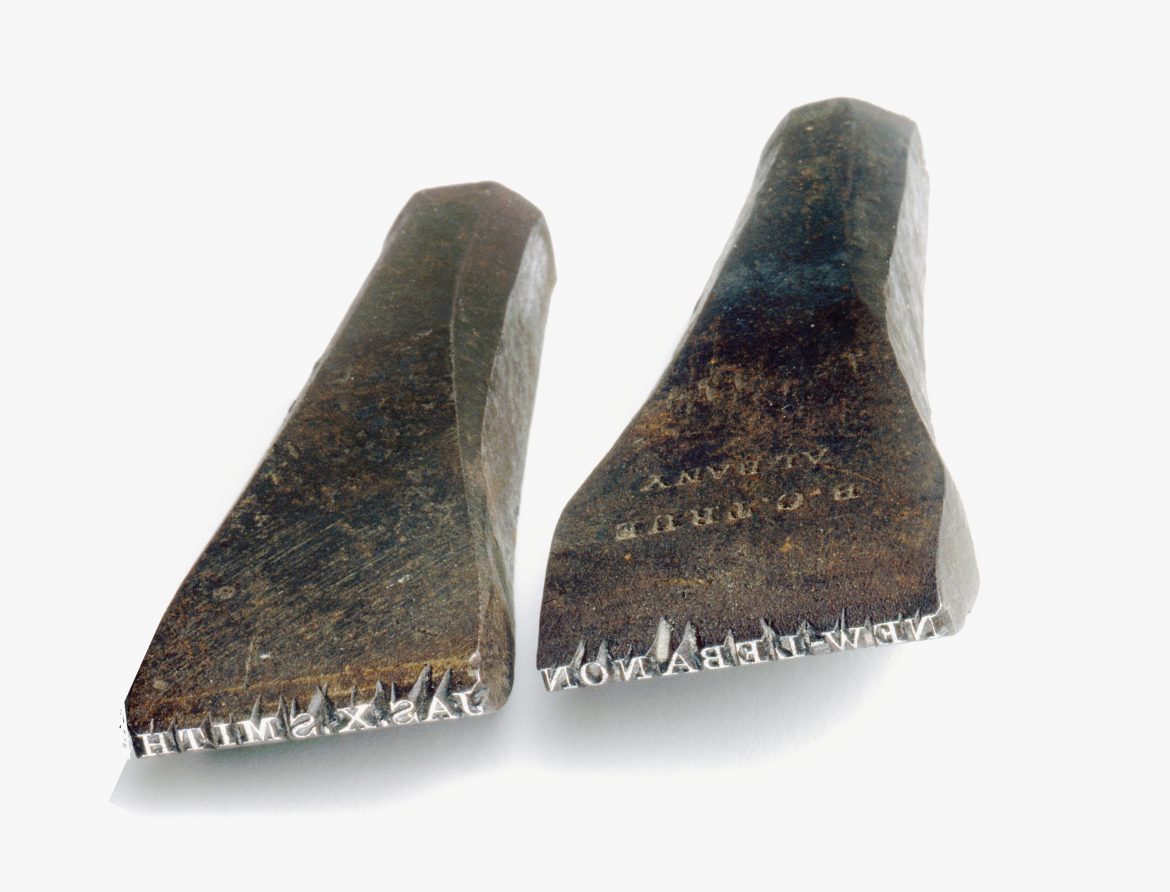
Die Stamps made by Benjamin C. True, Albany, NY for Brother James X. Smith, New Lebanon, NY, 1830s, Shaker Museum | Mount Lebanon, 1950.1403, 1950.1404
Die stamps were standard tools used by cabinetmakers to mark their tools, especially when they worked in a workshop where their tools might become mixed up with those of other workers. This set of stamps was used by James X. Smith to make his mark “Jas. X. Smith” and “New-Lebanon” on his cabinetmaking planes and […]

Jas. X. Smith’s Stamp in Wood, ca. 1950, Shaker Museum | Mount Lebanon.
Die stamps were standard tools used by cabinetmakers to mark their tools, especially when they worked in a workshop where their tools might become mixed up with those of other workers. This set of stamps was used by James X. Smith to make his mark “Jas. X. Smith” and “New-Lebanon” on his cabinetmaking planes and other tools. While it is common to find initials stamped into the ends of woodworkers’ hand planes and occasionally a full last name, it is less common to find the owner’s whole name and place of residence marked. Brother James X. Smith was a member of the Shaker community at Mount Lebanon, New York. Born in 1806 in Norwich, New York, his father, also James had unsuccessfully tried to become a Shaker at New Lebanon in the 18th century. Failing this, he dedicated himself to the work of farming and met with considerable success. He married and had eight children, including James X. Smith. Although comfortably rewarded by his labor, he never found spiritual peace. In a complex series of steps having to do with his earlier experience with the Shakers and with his duty to his wife and family, James Sr. and most of his family united with the Shakers at New Lebanon in 1816. By 1843 Brother James X. Smith was serving as the assistant elder at the Second Family. In 1858 he was moved to the Center Family where he worked in the herb business. Two years later he was appointed the Elder at the East Family, but due to poor health was sent to the Church Family where he led a productive life until he died in the faith in 1888.

Die Stamps made by Benjamin C. True, Albany, NY for Brother James X. Smith, New Lebanon, NY, 1830s, Shaker Museum | Mount Lebanon, 1950.1403, 1950.1404
The stamps Brother James used were made by and purchased from die-cutter Benjamin C. True of Albany, NY, and marked “B. C. True, Albany.” True was active in the 1830s with a shop on Beaver Street. The process of making dies was challenging—carving very small letters into iron that is hard enough to be driven repeatedly into hard wood without damaging the die. The process involves forging the general shape of the die at the blacksmith’s forge, then annealing or softening the iron by heating it to the temperature at which it is no longer attracted to a magnet – somewhere around 1600 degrees Fahrenheit – and then letting it cool very slowly. Done properly, the iron will be soft enough to be worked with small chisels, files, drills, and engravers’ tools. The die-maker works with letters in reverse so they will make a right-reading mark. Once the die is cut, it is hardened by bringing it evenly back to around 1600 degrees Fahrenheit and quenching, that is, quickly cooling the iron. Done properly the die will withstand repeated use.
Earlier this week Shaker Museum | Mount Lebanon sponsored a tour of the current Shaker exhibition at the Metropolitan Museum of Art, “Simple Gifts: Shaker at the Met,” on view through June 25,2017. The exhibition, curated by Alyce Englund, Assistant Curator of American Decorative Arts, features Shaker pieces once owned by pioneer collectors and scholars of Shaker history, Edward and Faith Andrews, along with other Shaker items from the Met’s collection; examples of American furniture contemporary with Shaker pieces; and modern pieces inspired by the Shakers, including a 1958 screening of Martha Graham’s Appalachian Spring ballet. The Museum’s Director of Collections and Research, Jerry Grant, was invited to join Englund in discussion of the objects in the exhibition.

Work Stand, Made by Brother James X. Smith, Second Family, Mount Lebanon, NY, 1843, Metropolitan Museum of Art, New York, NY, photograph by Paul Rocheleau.
One of the extraordinary pieces in the exhibition is a six-drawer work table from Mount Lebanon made in 1843 by Brother James X. Smith while he lived at the Second Family. Brother James used the set of dies to stamp “Jas. X. Smith New-Lebanon N. Y.” across the dovetails of one of the piece’s drawers. The work table is unusual in that it is of panel-and-frame construction at a time when Shakers would usually have made such a piece with wide pine boards to make the sides. The front legs and the boards between the drawers are framed with beading. Brother James edged with top with a strip of wood to keep things from rolling off and marked the front strip to be a 32 inch measuring stick. In anticipation of discussing this piece, Grant brought photographs of Brother James’ stamps for Englund. The Met was unaware of the existence of these stamps and the knowledge of them enhances the story of this particular piece of Shaker furniture.